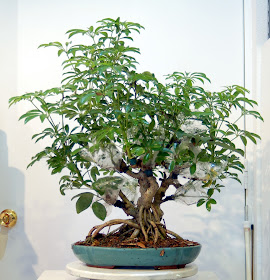This Schefflera arboricola has become a favorite on the bench and also a long long history with me. It also is a great example of taking a leap to make a tree better. While not the most impressive of its species, it holds a special place in my heart. Here it is today:
Going back, this was a patio plant belonging to my grandmother in Houston. She moved from her home and I inherited it back in 1992. For her, it was a 6-foot tall, long limbed tropical she kept propped up against the wall of her greenhouse-back porch. I always remember it being there, so she must have had it since the 70's or maybe 60's. I regret that I can't find any of the early gangly photos, but if you've seen these in people's homes or offices, you get the picture. I also kept it as a tall tree for about 10 years and finally one day decided to give it a low chop and turn it into a bonsai (I was so tired of it always blowing over in the wind!). A few years later it grew out to look like this:
I had worked on encouraging branching and proportion, but the problem was that each leaf was about the size of an open hand.. very coarse growth. I would cut the long shoots short to encourage smaller internodes.
Which seemed to help, but with further growth, it just looked overwhelming large again. I also defoliated it several times to try to encourage finer or even weaker growth.
It looked great for a short time, but after a small leaf or maybe two, it would resume the large leaf form. As an added problem, I found that defoliating it meant that some of the shoots and branches would unpredictably die back each time. Not a great reaction for bonsai.
Something had to give, and luckily I met two new members of our local Austin Bonsai Society who moved here from Florida and had a dwarf variety of Schefflera called Hawaiian Elf. I took cuttings from their tree, and as you can see it has a much better and smaller habit than this big species variety.
Comparing the leaf size next to each other was startling! (And keep in mind this is Shefflera arboricola, not Schefflera actinophylla (the huge leaf Umbrella tree)
About this time I was getting into grafting, learning about adding branches and shoots and I decided to change out the foliage of this tree and see how it would do. End tips were selected from the Hawaiian Elf variety and they were grafted into the branches, the union wrapped with Parafilm. Then small plastic baggies were wrapped around the new graft to hold in moisture and it was all wrapped tightly with green plastic garden tape.

These were done in August, in the heat of summer to increase the likelihood of success.
After a few weeks I could see the new growth in the bag, so opened it just a little in the corners.
By a month, the bags were completely opened and the ends were growing out of their confines.
I cut away the plastic, but kept the wrapper on because I didn't want these new branches breaking off.
Eventually all the wrapping came off and they were supporting themselves. They were actually outgrowing the original foliage, which was still left on as a safety.
Then all the original larger foliage was removed and the grafts were the only source of foliage.
These grew really well and surprisingly the original big leaves never have returned as a backbud. The tree seemed to like the additional foliar mass the smaller leaves provided.
This new smaller leaf variety also makes it possible to wire and change direction of the branches because the diameter is much smaller - an added bonus!
So that's the story of "Granny's Schefflera" which is somewhere in the age range of 40-50 years and has passed through at least two generations of my family. It continues to grow strong and now has some added chapters to its book.















































